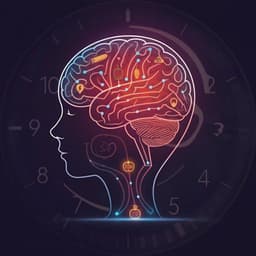
Psychology
Enhancing attention in children using an integrated cognitive-physical videogame: A pilot study
J. A. Anguera, M. A. Rowe, et al.
Discover the potential of Body-Brain Trainer (BBT), a groundbreaking cognitive-physical videogame designed to enhance attention in children aged 7-12. This pilot study, conducted by authors from the University of California, San Francisco, reveals significant improvements in attention that last for over a year. Join us in exploring this innovative non-pharmaceutical approach!
~3 min • Beginner • English
Introduction
The study addresses the need for non-pharmaceutical interventions to improve attention in children across a spectrum of abilities, including those with ADHD and typically developing children who show variability in cognitive control. Given side effects and limitations of stimulant medications, there is interest in validated, scalable alternatives. Prior work shows benefits of cognitive training and physical exercise on executive functions, and exergames offer a combined, potentially efficient approach. Key questions were whether an integrated cognitive-physical, closed-loop video game (BBT) is feasible as an after-school program, whether it improves attention as measured by parent reports, cognitive performance, and neural markers, whether benefits generalize across children with heterogeneous attention abilities, and whether gains persist over time. The present single-arm, proof-of-concept pilot aimed to evaluate feasibility, efficacy on attention outcomes, and 1-year retention of effects.
Literature Review
The paper surveys evidence that cognitive training and physical exercise independently improve executive functions in children, including those with inattention/ADHD. Exergame studies have shown benefits on executive function but often lack parent-report outcomes, neural mechanisms, or durability assessments. The authors’ prior work and others’ digital therapeutics (e.g., AKL-T01) have demonstrated improvements in attention and related neural markers with closed-loop adaptivity. Fitness-based interventions correlate with real-world outcomes (academic performance, health), and cardiorespiratory fitness is linked to cognitive control and mental health. Existing combined cognitive-physical interventions in other populations suggest additive or complementary benefits, but practical delivery outside laboratories and sustained effects in children remain less explored.
Methodology
Design: Single-arm, open-label, longitudinal pilot conducted as an after-school program at a local elementary school. Duration/Dose: 24 BBT sessions over 8 weeks (~30 min/day), typically 4 sessions/week across 6 weeks with ramped physical intensity to weeks 3–8, and overall 8-week period. Feasibility targeted a real-world school setting with one child per training session and a research assistant present.
Participants: 22 children (6 female), ages 7–12 (mean 9.24±1.57) completed the intervention; 16 completed 1-year follow-up. Recruitment was all-comers: parental concerns of inattention, ADHD diagnosis, or neither. Inclusion: WISC-V VCI ≥70. Exclusion: prematurity (<32 weeks), seizures requiring medication, suspected ASD (SCQ >15). Study registered (ISRCTN59416198); IRB approval (UCSF). Caregivers provided consent; children assent. Compensation: $20 per outcome session, $5 per training session.
Intervention (BBT): A closed-loop, integrated cognitive-physical 3D video game using Microsoft Kinect 2 for full-body motion capture and Apple Watch for real-time heart rate. Three modules trained cognitive control pillars: (1) Visual search (attention; increasing distractor load and reduced cues), (2) Spatial working memory (Corsi-like with delays and motor actions; increased load and sequence/order demands), (3) Task switching (morphing stimuli, increasing interference and visual search demands). Difficulty adaptively titrated trial-by-trial via response window staircasing (1-up/3-down) targeting ~80% accuracy; module-specific scaling (distractors/cues, memory load, morph similarity). Physical adaptivity adjusted required movement amplitude and time constraints based on HR relative to a VO2max-derived target zone. VO2max estimated from PACER per Mahar et al. 2018; HR intensity ramped from 50–60% VO2max (week 1), 60–70% (week 2), 70–80% (weeks 3–8). Hardware: Windows PC, large display, Kinect 2, Apple Watch or HR monitor; supervised by a research associate.
Outcomes and Timing: Primary outcomes at baseline (pre), post-intervention, and 1-year follow-up:
- Parent report: Vanderbilt ADHD Diagnostic Parent Rating Scale (inattention items 1–9; research criteria applied).
- Cognitive: Continuous Performance Task (CPT; modified TOVA) sustained and impulsive conditions; primary metric response time variability (RTV); also RT, d′, ex-Gaussian tau.
- Neural: EEG during CPT; BioSemi ActiveTwo 64-channel, 1024 Hz; preprocessing with ICA and artifact rejection; frontal cluster (Fz, FPz, AF3, AF4, AFz). Inter-trial coherence (ITC; phase-locking value) at 4–40 Hz; 50-ms bins from 0–600 ms; baseline corrected (−200–0 ms). Sustained condition assessed for session×time-window interactions; peak window follow-up (100–150 ms).
Secondary outcomes: NeuroRacer multitasking assessment (d′ multitask cost; visuomotor tracking), delayed-recognition working memory (Ignore Distractor condition; accuracy and RT), physical fitness (FitnessGram: Curl-Up, 90° Push-Up, Trunk Lift, PACER laps; max HR; estimated VO2max), and a Basic Response Time (BRT) task (RT, RTV) as a control. Some secondary outcomes not collected at 1-year due to time.
Feasibility metrics: Setup practicality, attrition, session completion percentage.
Statistical analysis: Paired t-tests for pre–post, post–1-year, pre–1-year comparisons (limited repeated-measures due to missingness). EEG ITC: repeated-measures ANOVAs with within-subjects factors session (pre, post) and time-window (0–600 ms, 50-ms bins) per condition; Wilcoxon signed-rank for post–1-year due to small N. Correlations (Pearson) between changes in neural ITC and behavioral outcomes; false discovery rate (FDR) noted where applicable. Effect sizes (Cohen’s d). Historical comparisons to prior cohorts (TDC, SPD+IA using AKL-T01) via repeated-measures ANOVA (session×group) and follow-up tests.
Key Findings
Feasibility and Engagement:
- High compliance: participants completed on average 95.8% of required sessions (mean 23.0±2.5/24). Within-game metrics improved: training accuracy increased (t(21) = −7.3, p<0.001) and heart rate increased (t(21) = −3.5, p=0.002) from early to late sessions.
Primary Outcomes:
- Parent-reported inattention (Vanderbilt, items 1–9): significant decrease (mean improvement +3.72 points; t(21)=3.65, p=0.002). 16/22 improved; 7/8 who met Vanderbilt research ADHD inattentive criteria at baseline no longer met criteria post.
• Correlation: Change in Vanderbilt vs. change in BBT training accuracy r=0.42, p=0.05.
• Durability: Post vs. 1-year follow-up not different (t(15)=0.001, p=0.99); 1-year vs. baseline not significant (t(15)=1.57, p=0.14).
- CPT RTV (primary cognitive metric):
• Sustained condition: improved (t(18)=2.46, p=0.024). 1-year: post vs. 1-year no difference (t(12)<1.01, p>0.34); 1-year vs. baseline significant (t(11)=2.68, p=0.02) indicating sustained benefit.
• Impulsive condition: improved (t(18)=3.83, p=0.001). 1-year: post vs. 1-year no difference (ns); 1-year vs. baseline not significant (t(11)=0.70, p=0.50).
- EEG ITC (midline frontal theta):
• Sustained condition: session×time-window interaction (F(11,132)=2.45, p=0.04). Peak 100–150 ms window increased post (t(12)=2.20, p=0.05). Change in sustained ITC correlated with Vanderbilt improvement (r(13)=0.74, p=0.004; survives FDR p=0.04).
• Impulsive condition: main effect of session (F(1,13)=7.12, p=0.02) and time-window (F(11,143)=14.74, p=0.0001); no interaction. ITC change (across windows) correlated with RTV improvement on impulsive CPT (r(12)=0.58, p=0.05); not with sustained RTV (r(11)=0.23, p=0.49). Post vs. 1-year ITC: no significant differences; baseline vs. 1-year also ns.
- Baseline severity vs. change: No significant correlations between baseline Vanderbilt inattention and improvement on primary measures (CPT sustained RTV r=0.35, p=0.14; CPT impulsive RTV r=0.12, p=0.63; ITC sustained r=0.40, p=0.17; ITC impulsive r=0.08, p=0.77).
Secondary/Exploratory Outcomes:
- NeuroRacer multitasking cost improved (t(19)=4.17, p=0.001); post vs. 1-year no difference (t(13)=0.19, p=0.85); baseline vs. 1-year ns (t(10)=1.16, p=0.14). Visuomotor tracking showed similar improvements (details partially truncated in text).
- Working memory (Ignore Distractor): accuracy trend to improve (t(16)=1.95, p=0.07); RT no change (t(16)=0.80, p=0.44).
- Physical fitness: improvements on Curl-Up (t(19)=2.35, p=0.03) and max HR during PACER (t(19)=2.50, p=0.02); Trunk Lift trend (t(19)=1.95, p=0.06). No change in Push-Up (t(19)=1.06, p=0.30), PACER laps (t(19)=0.72, p=0.47), or VO2max estimate (t(19)=0.94, p=0.36).
- Control BRT task: no change in RT (t(20)=1.44, p=0.17) or RTV (t(20)=1.14, p=0.27).
Historical comparison: Magnitude of improvements on Vanderbilt and CPT RTV were comparable to prior cohorts using a different digital therapeutic (AKL-T01) for children with inattention; typically developing children in prior work showed minimal Vanderbilt change. ANOVAs showed main effects of session and group×session interactions consistent with greater gains in inattention groups.
Discussion
Findings indicate that a closed-loop, integrated cognitive-physical videogame (BBT) is feasible to deploy as an after-school program and can improve both subjective (parent-reported inattention) and objective markers of attention (CPT RTV) along with neurophysiological correlates (midline frontal theta ITC) in a heterogeneous sample of children. Improvements were comparable in scale to prior digital therapeutic studies and, for sustained attention, appeared to persist at 1 year. The neural results suggest enhanced consistency of frontal theta engagement supporting attention control, aligning with past work linking theta synchrony to reduced response variability. Benefits did not depend on baseline inattention severity, implying applicability across a spectrum of children rather than only those most impaired. Secondary outcomes suggest broader gains in multitasking and some aspects of physical fitness, consistent with intended targeting of attention, working memory, and cognitive flexibility alongside moderate-intensity aerobic engagement. Lack of changes on basic RT indicates effects are not attributable to generalized motor speeding. Practical considerations (declining hardware costs, school-based implementation) support scalability. Together, the cognitive, behavioral, and neural results strengthen the case for digital therapeutics targeting cognitive control networks through adaptive, engaging gameplay that integrates physical exertion.
Conclusion
This pilot demonstrates that an integrated cognitive-physical, closed-loop videogame (BBT) can be feasibly delivered in a school setting and is associated with improvements in parent-reported inattention, sustained and impulsive attention performance, and frontal theta ITC in children with heterogeneous attention abilities. Some benefits, particularly in sustained attention, persisted at 1 year. Exploratory results indicate gains in multitasking and elements of physical fitness. Future work should include randomized controlled trials with appropriate active control conditions, larger and more homogeneous clinical ADHD samples, comprehensive assessment of durability, and deeper investigation of neural mechanisms to optimize personalization and scalability.
Limitations
- Single-arm, open-label design limits causal inference and cannot fully control for expectancy or practice effects; comparisons rely on historical controls.
- Small sample size overall and reduced numbers at 1-year follow-up constrain statistical power and generalizability.
- Heterogeneous sample (all-comers) may introduce variability; results may differ in a strictly defined ADHD cohort.
- Multiple correlational analyses with only one surviving FDR correction; other correlations are exploratory.
- EEG metric (ITC) and task differ from some related studies using theta power; interpretability across studies may vary.
- Potential unmeasured confounds (changes in health, outside activities) were not controlled.
- Some secondary outcome data were truncated or not collected at 1-year due to time constraints; missing data for CPT/EEG due to scheduling and hardware issues.
Related Publications
Explore these studies to deepen your understanding of the subject.







